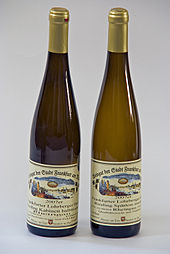Winery of the city of Frankfurt am Main
The city of Frankfurt am Main's winery extends over acreage in the Rheingau wine-growing region in Hochheim am Main and Frankfurt am Main . The city cultivated its own vineyards until 1994 , but then leased the business in Hochheim to Armin Rupp, a tenth generation winemaker from Framersheim in Rheinhessen .
history
The winery of the city of Frankfurt am Main has existed since 1803. In the Reichsdeputationshauptschluss of February 25, 1803, the deputies of the then Free Imperial City , including Simon Moritz von Bethmann , had secured the sovereignty and neutrality of Frankfurt through clever negotiations and achieved that the city Collegiate monasteries and monasteries located on their territory along with their foreign goods. In return, she had to renounce her rights to the imperial villages of Soden and Sulzbach . With this secularization , the wineries and farm buildings of the Carmelite monastery and the Dominican monastery also came into the possession of the city.
The new urban vineyards were in Hochheim am Main, Flörsheim am Main and Hörstein . Except for the Hochheimer locations, a total of around 2.5 hectares, they were soon sold because of their low yields. The wines produced in Hochheim were served on official occasions and to entertain state guests.
After the annexation of the Free City of Frankfurt by Prussia in 1866 and the subsequent dispute over state and municipal assets in the Frankfurt recession , the city was allowed to keep its vineyards. By 1935, the winery was gradually expanded to around 25 hectares.
At the beginning of the 1990s, the winery generated considerable deficits over the years, which burdened the city budget with 1.8 million DM annually . Since the city did not want to completely give up its winery and the associated image gain, it leased the winery including the public sales point in the town hall for 30 years to a family company from Framersheim near Alzey.
Wines
A total of 24 hectares in the well-known Hochheimer locations Domdechaney and Kirchenstück as well as in the locations Hofmeister , Reichestal , Stein and Stielweg belong to the winery. There grow alongside Riesling also white and Pinot Noir , Chardonnay , Sauvignon Blanc and Cabernet Sauvignon . A total of around 200,000 bottles are filled each year. The city of Frankfurt itself is the largest buyer of urban wine.
A special feature is the 1.3 hectare Lohrberger slope , the only location in the district of Frankfurt. The Lohrberg became part of the city area on July 1, 1900 through the incorporation of the northeastern rural community of Seckbach . In 1924, horticultural director Max Bromme laid out the vineyard as part of the Lohrpark . Since 1971 it has been the smallest and most easterly vineyard in the Rheingau wine-growing region . The city itself is responsible for the marketing of the wine produced . Any possible profit will benefit the city budget. As the only real Frankfurt wine grown in the city, it is often served on festive occasions.
On the occasion of the Soccer World Cup 2006 , the winery produced two white wines and one red wine with the FIFA World Cup 2006 logo, which were marketed as the official World Cup wines of the FIFA World Cup City of Frankfurt am Main.
The entire wine range of the municipal winery is offered in Frankfurt's Römer town hall . The bar and sales rooms are in the Alt-Limpurg building , on the corner of Limpurgergasse. The wines are also available on the Lohrberg in the Lohrbergschänke garden restaurant and in the MainÄppelHaus . There, a tour or circumnavigation and, if necessary, crossing of the Lohrberger Hang vineyard can easily be combined with a wine tasting.
literature
- Folker Rochelmeyer: Seckbach and its surroundings. Frankfurter Sparkasse von 1822 - Polytechnische Gesellschaft (Ed.), 1972, 84 pages, illustrated
- Friedrich Bothe: History of the city of Frankfurt am Main. Frankfurt 1977. Verlag Wolfgang Weidlich, ISBN 3-8035-8920-7
- Martin Heinzberger, Petra Meyer, Thomas Meyer (arr.): Development of gardens and green areas in Frankfurt am Main. Small writings, volume 38, Historisches Museum Frankfurt am Main (ed.), Ibid., 1988
- The Lohrpark in Frankfurt am Main - fire protection and urban green. City of Frankfurt am Main, Garden and Cemetery Office, Department for the Environment (ed.), 32 p., Ibid., 1989
- Hugh Johnson: Atlas of German Wines. 4th edition, Hallwag, Bern and Stuttgart, 1993, ISBN 3-444-10369-7
- Roland Bolliger: Viticulture in Seckbach. Culture and History Association 1954 Frankfurt a. M.-Seckbach e. V. (Ed.), 2005
Individual evidence
- ↑ https://www.fnp.de/lokales/main-taunus/winzer-erzaehlt-seiner-leidenschaft-10445063.html
- ↑ Municipal winery on: frankfurt.de
- ↑ Urban wine on: frankfurt.de
- ^ Ernst Georg Gerhard: History of the secularization in Frankfurt am Main. Schöningh, Paderborn 1935
- ↑ The city fathers were not particularly well suited as winemakers . In: Frankfurter Allgemeine Zeitung . February 25, 2003
- ^ In: Frankfurter Allgemeine Zeitung. March 11, 1994



